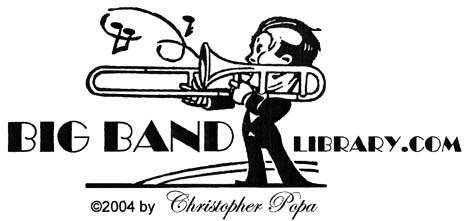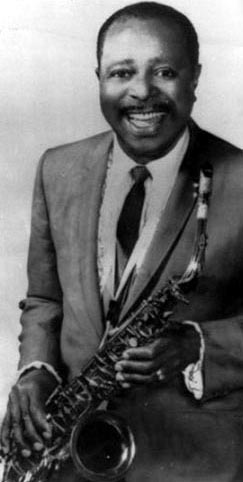
vital stats:
given name Louis Thomas Jordan
birth Jul. 8, 1908, Brinkley, AR
death Feb. 5, 1975, Los Angeles, CA, heart attack
grandfather Louis Jordan
grandmother Maggie Jordan
father James Aaron Jordan, a musician, b.Jun. 16, 1876, d.June 15, 1962
mother Adell, d.ca.1910
uncle Mack Reid
aunt Lizzie Reid
first wife Julia ("Julie")
stepdaughter Patty
second wife Ida M. Fields, a singer and dancer, b.Sept. 4, 1892?, m.1932 [ though he hadn't
been divorced from Julia ], d.May 27?, 1990
third wife Fleecie Ernestine Moore, d.1989
fourth wife Florence "Vicky" Hayes Johnson, m.Nov. 14, 1951, d.
fifth wife Martha Weaver, a dancer, b.1927?, m.June 14, 1966
education Consolidated White River Academy, Brinkley, AR; Marion Anderson High School,
Brinkley, AR; enrolled at Arkansas Baptist College, Little Rock, AR
memberships Local 274, American Federation of Musicians, Philadelphia, PA; Local 802,
American Federation of Musicians, New York, NY, spring 1936-
residence 2135 7th Ave., New York, NY [ 1938 ]; Purple Dr., Phoenix, AZ [ 1950 ]; 6011
Buckler Ave., Los Angeles, CA [ early 1960s ]
Apart from being a good, disciplined musician, Jordan initially listened to other bands and players for ideas. Gradually, he developed an individual, rhythmic style of singing and playing, along with his own sense of showmanship and "stage business." Also, he was constantly on the lookout for appropriate, well-written material, whether pop, swing, blues, or novelties.
For his band's recording debut, on December 29, 1938, he had added a bassist, resulting
in a change to the now-classic moniker "Louis Jordan and his Tympany Five." (Later, he would add a tenor saxophonist and, occasionally, other instruments, but the "Tympany Five" name would remain.)
With the helpful direction of Berle Adams, an agent with the General Amusement Corporation (GAC), who became his manager for about nine years starting in 1941, Jordan's hopes and dreams began to pay off.
After a successful opening that May at the Capitol Lounge in Chicago, Adams got them a job at the Fox Head Tavern in Cedar Rapids, IA, where, to alleviate boredom, the members of the band were more than willing to attend continual rehearsals and work out many of their routines.
When they returned to the Capitol Lounge in early 1942, they had a wealth of material and became an "overnight" sensation.
During the decade of the '40s, Jordan's popular repertoire grew to include I'm Gonna Move to the Outskirts of Town, Five Guys Named Moe, Is You Is Or Is You Ain't (My Baby), G.I.
Jive, Buzz Me, Caldonia Boogie, Beware, Choo-Choo Ch'Boogie (which became a million-seller), Ain't Nobody Here But Us Chickens, and Saturday Night Fish Fry, Parts 1 and 2.
He and the Tympany Five played at various theatres around the Chicago, Cleveland, Detroit, Baltimore, Washington, DC, et al circuit, as well as -- surprisingly because of the group's small size -- in various ballrooms.
Jordan actually once organized a big band, for a tour in 1951, and made some recordings with it that June and July that were released as "Louis Jordan and His Orchestra."
The personnel of the Tympany Five included, at various times, Courtney Williams or Eddie Roane or Aaron Izenhall (trumpet), Lem Johnson or Josh Jackson or Eddie Johnson (tenor saxophone), Clarence Johnson or Arnold Thomas or "Wild Bill" Davis or Bill Doggett (piano), Charlie Drayton or Al Morgan or Jesse "Po" Simpkins or Dallas Bartley (bass), and Walter Martin or Eddie Byrd or Chris Columbus (drums).
Louis Jordan in His Own Words:
"See, before I got a band, I knew what I wanted to do with it. I wanted to give my whole life to
making people enjoy my music. Make them laugh and smile. So I didn't stick to what you'd call
jazz. I have always stuck to entertainment."
"I wanted to play music on stage that made people forget about what they did today."
"Every time I used to go to the Apollo I'd get hoarse. Why? Because it was a filthy theatre. The
same dirt was there from year to year. To tell you how I know - I used to put a mark in it - and I'd
come back to play there again and my mark would be there."
"Milt Gabler of Decca, he's one of the main fellows in my life. If we were recording a tune and I said,
'I would like to do it this way' he never said, 'No, don't do it that way.'"
"Generally a black artist at that time would either stick to the blues or do pop. I did everything."
"A showman must 'intrigue' the customers. He must hold their interest from one minute to the next
to keep them guessing as to what's coming."
Jordan stayed with Decca Records until late 1953, then recorded for Aladdin during 1954. He switched to "X" in 1955-56, then signed with Mercury from October 1956 to April 1958, and was heard on various smaller labels after that.
His final records, the LPs "I Believe in Music" [ Black and Blue ( Fr ) 33059 ]; "Jump'n'Jive"
[ JSP Records ( UK ) 1069 ]; "Sweet Georgia Brown," with Wallace Davenport
[ My Jazz 135 ]; and "I Shall Not Be Moved," accompanying a gospel singer, Sister Aline White
[ Pontchartrain P.140 ], were made in late 1973 to August 1974.
Jordan, meanwhile, continued to appear at clubs and concerts in the U.S. and overseas from the '50s to the early '70s, and fronted a specially-assembled version of the Tympany Five for a Newport Jazz Festival program, held at Carnegie Hall in New York City on July 6, 1973.
He suffered a severe heart attack in late 1974, then died from a second attack a few months later.
All that jumping and jiving that Jordan did on stage during his performing career was surprising, in light of the fact that, due to a congenital weakness in his lower abdomen, he suffered from a persistent hernia from the time he was a teenager.
"Since surgery was impractical, the only answer was to wear a truss," Jordan biographer John Chilton once explained. "Embarassed though he was, Louis accepted the advice and wore a cumbersome remedial truss, vowing that he would never let the problem affect his mobility. As if to prove himself, he made his on-stage performances as vigorous and mobile as possible, so that people who saw him doing high kicks . . . would never have guessed that he suffered from this chronic problem."
Jordan certainly let the good times roll!
sources:
All Time Million Seller Recordings, ca.1964.
John Chilton, Let the Good Times Roll: The Story of Louis Jordan & His Music (Ann Arbor,
MI: The University of Michigan Press, 1994).
Leonard Feather, "Jordan, Louis," in The Encyclopedia of Jazz (New York City: Horizon
Press, 1955), p.294.
Peter Grendysa, liner notes, "Louis Jordan: Let the Good Times Roll: The Complete US
Decca Recordings 1938-1954," Bear Family ( G ) BCD 15557, 1992.
Tom Lord, "Louis Jordan," in The Jazz Discography (Redwood, NY: Cadence Jazz Books),
pp.J590-J605.
I would like to expand this tribute with, if possible, a new interview of someone who was important to Louis Jordan's life or career. Are you an alumnus of his band, a member of his family, or a collector who is knowledgeable about his accomplishments? Please contact me via e-mail
return to "Biographical Sketches" directory
go to Big Band Library homepage
The big bands are back
in a new and exciting way!
LOUIS JORDAN
"JUMP AND JIVE
WITH THE TYMPANY FIVE"
by Music Librarian CHRISTOPHER POPA
November 2008
As a youngster, he played the trombone. However, since he was only 8 years old, his arms weren't long enough to extend the slide beyond the third position.
So he switched to the clarinet and, later, the different saxophones.
In late July 1936, he rose to prominence when he joined drummer Chick Webb's band, but clashed with him and, after a couple years, was let go.
He then joined pianist-arranger Edgar Hayes' orchestra.
Afterwards, although the "big band era" was in full swing while Jordan started his own group for a job which began on August 4, 1938 at the Elks Rendez-vous on Lenox Ave. in New York City, he opted for a quartet (trumpet, piano, drums, plus his alto saxophone, clarinet, and vocals).
First billed as "Louie Jordan's Elks Rendez-vous Band" (spelling his name "Louie" so people would know not to pronounce it like "Lewis"), they became "Louis Jordan's Tympany Four" (a mis-spelling of the word "timpani," which would be perpetuated during most of his career).
After he added another player, he was one step closer to becoming a star as leader of the Tympany Five.
